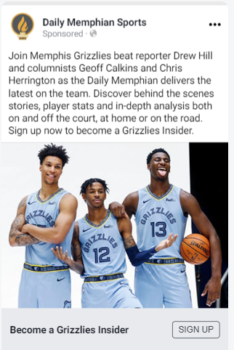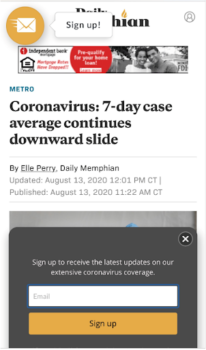How the Daily Memphian grew newsletter subscribers to more than 40,000 in fewer than two years
Wendy Greenlaw and Kevin Lipe, Daily Memphian,This is a series on Better News a) to showcase innovative/experimental ideas that emerge from the Knight-Lenfest Newsroom Initiative and b) to share replicable tactics that benefit the news industry as a whole. This “win” comes from Wendy Greenlaw, director of audience development, and Kevin Lipe, director of product strategy, both of the Daily Memphian, which was part of the 2019-20 Poynter Local News Innovation Table Stakes cohort.
Question: What problem were you trying to solve, and why was solving the problem strategically important for your organization?
Answer: The Daily Memphian, launched in September 2018, is a nonprofit news organization providing in-depth journalism in Memphis, Tenn.
Frustrated by the gutting of local journalism in Memphis, a group of seasoned journalists, media professionals and concerned citizens gathered to discuss the need for strong, locally focused and locally produced daily news.
After much research and outreach to local and national media professionals, Memphis Fourth Estate Inc. was formed. The 501(c)(3) owns and operates the Daily Memphian, but the newsroom operates independently of Memphis Fourth Estate’s influence.
As a startup, we aim to become self-sustaining by the end of 2023. To do that, we need to maintain 25,000 digital subscribers paying an average of $10/month. We want to achieve this without flash sales or gimmicky offers.
We had more than 10,000 digital subscribers and 29,000 newsletter subscribers at the end of our first year. Based on these figures, we realized that we needed to significantly grow our readership to achieve our five-year goal.
Q: How is this approach related to Table Stakes (e.g. one of the 7 Table Stakes and/or an outgrowth of the Knight-Lenfest initiative, etc.)?
A: This effort is related to Table Stake No. 4 (Funnel occasional users to habitual and paying loyalists).
Q: How did you go about solving the problem?
A: We started by analyzing our existing newsletters by examining open rates, campaign views and propensity for conversion to identify which newsletters we wanted to focus our efforts on to acquire new newsletter subscribers through email acquisition strategies.

The Grizzlies Insider Facebook lead campaign, promoted to custom audiences with an interest in Memphis Grizzlies, generated more than 500 new email addresses.
One such newsletter is The Early Word, which we launched in November 2019. It has been hugely successful for converting new readers to paying subscribers. The Early Word is personally curated each business day by our digital director and includes direct access to our most popular local news stories. It is among our most-read newsletters based on open rates and campaign views.
As we analyzed our newsletters and reader survey feedback, we realized that we needed to simplify how existing newsletter subscribers manage their email preferences. We also needed to provide new subscribers an opportunity to review all of our newsletter offerings and allow them to opt-in from a centralized location on our website.
Our product development team created a customized email landing page allowing new subscribers and potential subscribers to easily sign up for any of our 15 free newsletters. This landing page is referenced in every email marketing campaign and editorial newsletter to ensure that both new and longtime newsletter subscribers have an opportunity to choose the news that most interests them.
We also implemented in-article newsletter sign-ups to coexist with our section page sign-ups. New readers who land on our article pages or section pages can easily sign up for newsletters related to the content they are reading.
We used Facebook lead campaigns to collect readers’ email addresses by targeting specific audiences that would most likely subscribe to particular newsletters such as sports, business, breaking news and food. To date, these campaigns have generated more than 6,400 email sign-ups.
When the COVID-19 pandemic hit, we implemented our first newsletter sign-up pop-up using Privy’s Convert tool, which allows you to create customized pop-ups, flyouts and other displays assigned to specific content pages.
This optional pop-up allows us to collect email addresses from new readers who land on our coronavirus page. Although this coverage is free and accessible to all readers, it was a good opportunity to solicit emails from readers who weren’t already logged into our website.
Weekly marketing email campaigns were sent to these new readers explaining the importance of our coverage and why it was free, and they also solicited digital subscriptions and donations. The pop-up has generated more than 1,600 new newsletter readers and resulted in 120 new digital subscribers.
We recently implemented a formal email onboarding process for new readers of our breaking news alerts and our curated “The Early Word” newsletter, which is published each business day. These emails welcome new readers, instruct them how to sign up for additional newsletters, and encourage them to subscribe or donate to support our mission.

The Privy email sign-up pop-up on our coronavirus section page that displays to users not logged into our site.
Q: What worked?
A: From our inception in September 2018 to July 2020, we were able to acquire 40,000 newsletter subscribers, an average of 1,888 per month. That was after we removed more than 4,000 inactive subscribers from our database in April 2020. These were mostly subscribers acquired at launch who hadn’t opened an email in more than 180 days or updated their email preferences through a re-engagement campaign.
Within the past year of implementing our email acquisition strategies, we have acquired 11,810 new readers and are now higher than 40,000. We still have a difficult time tracking new sign-ups on our customized newsletter landing page, but we have acquired more than 1,600 new readers through the Privy pop-up tool, more than 6,400 new readers through our Facebook campaigns, and roughly 3,500 through our section and article page sign-up tools.
We convert about 10% of our newsletter subscribers to digital subscribers. By expanding the number of newsletter subscribers we increase our digital subscription rates, and we currently have a little more than 14,000 digital subscribers.
Q: What didn’t work?
A: Tracking new email acquisitions from the customized landing page has been difficult as we also use this page for subscribers to manage their email preferences. We are still unable to track the exact number of new newsletter subscribers from this tool.
Our product development team will implement a thank-you landing page within the next few months so we can easily identify new sign-ups. As new emails are added through the page, a thank-you page will display, triggering an event in Google Analytics. Existing email newsletter subscribers who use the page to manage their preferences will not trigger this event.
Q: What happened that you didn’t expect?
A: We were surprised at how well the onboarding emails worked for those that signed up via our free coronavirus coverage. These emails came directly from our CEO and had a 1.81% conversion rate of new readers that became digital subscribers. We typically see a conversion rate well below 1% for our standard marketing emails soliciting subscriptions.
Q: What would you do differently now? What did you learn?
A: When implementing our Facebook lead generation campaigns, we should have consulted with a Facebook specialist. These ads need to be updated consistently — both the images and the copy.
As soon as the cost per email starts to creep above $2.00, we change out the image, primary text and/or headline. By continually testing new creative and copy we are able to keep our cost per lead (CPL) down. In cases where the CPL rises above our $2.00 threshold, we turn off the ad for a period of time and in some instances stop marketing certain newsletters altogether.
We also didn’t realize that we should continually test new audiences. By varying audiences and the ad creative, some of our leads ended up costing more than $8.00 on average, which didn’t align with our email acquisition goals.
Q: What advice would you give to others who try to do this?
A: If your budget allows, hire a part-time consultant or subject matter expert to assist with certain aspects of your initiatives if you need expertise that you don’t have in-house.
Also, test everything. That can’t be stressed enough. Facebook is a great tool for testing audiences. You may think you have a handle on the readers most interested in your content, and you may find that what you think isn’t true. Whether it’s age, interests or location, test your content and marketing campaigns across various audiences.
Q: Anything else you want to share about this initiative?
A: Start small. You don’t have to implement everything at once. If you have the budget or staff to start with only one project, then do that. We are a relatively small organization, and some of our initiatives take time to implement due to lack of resources or funding.